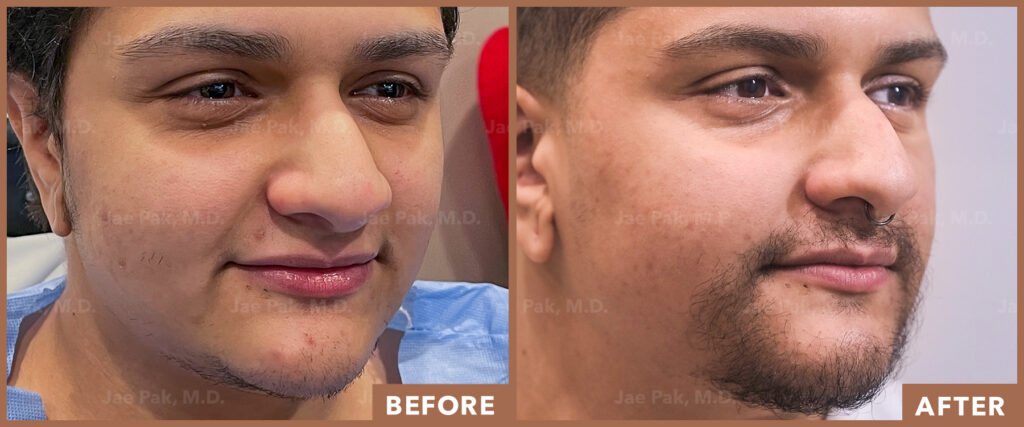
Making changes to one’s appearance is a critical element of the gender transition process. Everyone has different goals in their journey, but growing a full and masculine beard is most common for FTM individuals.
While hormone therapy is responsible for sparking the beard growth process for FTM patients, these protocols can only do so much for achieving the facial hairstyle you want. It takes time, patience, and ongoing effort to get the ideal beard, but it’s all worthwhile when those results are finally achieved.
Still, taking the first steps on the beard growth journey can be challenging, and it takes a while to gain momentum. Rather than playing with trial and error, we’ve outlined everything you should know about FTM beard growth and what to expect.
We’ll map out some tips to accelerate beard growth at every stage and offer a list of effective treatments and therapies popular in the FTM community to achieve dynamic and high-quality facial hair for the long term.
The basics of FTM beard growth may not be evident to someone starting in the transition process. Let’s learn the fundamentals before discussing tips, treatments, and more.
For most FTM patients, the facial hair goals are broad, but the common thread is achieving a more masculine look that is widely and quickly recognized.
While masculinization can take many forms – such as increased muscle mass and structural changes to the face – a full and robust beard is a clear signal of a masculine appearance, which cannot be obtained through styling, makeup, or other surface changes.
Furthermore, beard growth is a signal of effective hormone therapies and a good indicator that the transition process is smooth, efficient, and safe.
With that in mind, facial hair goals are often highly specific and unique to the individual, particularly when it comes to styles and configurations. In some cases, beard growth might not even be a top priority – but it’s something that will come with time.
The challenges of FTM beard growth are relatable for anyone going through this process.
While some people are quick to see beard growth as soon as they begin HRT (within a month or less), others do not see facial hair begin to sprout until several months or even an entire year.
There are also rare cases in which FTM patients see little to no beard growth even after years of hormone therapy, even if they increase the level of testosterone, anti-estrogens, and other compounds in their protocols.
The takeaway is that the FTM process is highly individualized, and no two people have the same experience from start to finish. This goes for beard growth, changes in vocal tonality, muscle development, and all other factors considered.
Additionally, facial hair growth follows less of a predictable pattern than hair growth than other changes that happen to the body during the transition. While some beards begin with a small mustache, others see hair appear along the chin, cheeks, or neck.
Seeing even minor facial hair growth is always a good sign, especially in the early stages! It’s only a matter of time before coverage and density improve. However, it is important to have realistic expectations for facial hair growth no matter where you are in the transitioning process.
Many of the variables at play are beyond the control of most hormone therapists, which is why we’ll discuss popular, widely-applicable hair restoration methods later on.
Facial hair will not appear overnight, even for FTM individuals on the perfect balance of hormones and a natural predisposition for beard growth.
Even if you feel like you’re making progress in the facial hair department, there are always ways to speed up and improve the experience. Here’s a list of FTM beard growth tips you can apply right now.
Many FTM people start the transition process without knowing what they want in their facial hair. Perhaps they have other priorities like body composition, or they just haven’t considered what their ideal beard will look like.
That’s why we recommend every FTM individual sets aside some time to think deeply about how they want their facial hair to look. This might involve highlighting pictures from magazines or movies or perhaps creating a “vision board” featuring people with similar structures and skin tones that could be replicable in the future.
There is a massive variety and customization in facial hair that may not even be on your radar, so don’t hesitate to dive deep and explore all the possibilities available.
At Jae Pak MD, we’ll guide you through it. It’s essential to have a vision for facial hair and all aspects of a person’s physiology as they advance in the transition process.
Having facial hair means adding a care routine to your daily regimen and getting used to the tasks and responsibilities of having a beard.
At first, this might just mean shaving with a basic razor and shaving cream since this is said to help facilitate facial hair growth in the early stages.
Besides, you may eventually want to sport a clean-shaven look once you’ve tried out some different facial hair styles down the road. Learn the ropes and always go with the grain – never against it!
A clean and well-cared-for beard will grow faster and look healthier, so take every step necessary to level up your beard care as soon as those first follicles appear.
You already know the skincare basics, from exfoliating and cleansing to applying toners, serums, and moisturizers. Things aren’t necessarily different when nurturing a new beard, but some specific products might be worth adding to your daily lineup.
Beard growth conditioners, for example, may contain compounds that promote growth, such as keratin, biotin, collagen, and others. These supplements are also available in pill or powder form to be ingested, which can help stimulate growth inside and out.
Many men and trans men also apply beard oils which contain extracts from powerful plants like lavender, aloe, tea tree, and peppermint. These products give your face a fresh and clean feel while giving you the best chance to grow the beard of your dreams.
Just beware of products that offer guarantees and make bold claims about facial hair growth because when it comes to these over-the-counter treatments, scientific support and studies are lacking in most cases.
Nevertheless, it’s worth trying everything natural and organic before jumping into more serious medicines and treatments for facial hair.
As mentioned before, the most critical factor when growing a beard as an FTM individual is time, regardless of your current status or medical history.
It can be frustrating to wait months or even years to see the progress you want. Still, applying these tips and using some of the methods in the next section can help accelerate these results and give yourself every advantage available.
Meet with Jae Pak MD Medical to learn more about FTM beard growth.
Request a Consultation
FTM beard growth starts with good hygiene, habits, and a persistently positive mental attitude. However, the following treatments and procedures can quickly take your facial hair growth to the next level.
Consider microchanneling as the new, high-tech version of microneedling that people have been using for years to stimulate hair and beard growth.
This technique utilizes an instrument with hundreds of tiny needles that make microscopic incisions in the target area – in this case, around the mouth, cheeks, jawline, and neck where facial hair should grow.
When these incisions are created with a precise technique with advanced equipment, it triggers a response in the body that boosts levels of collagen production, growth hormone, and other factors that promote hair growth.
The process is minimally invasive and demands little downtime or discomfort, and it has been identified as one of the most effective non-surgical treatments for facial hair growth.
At Jae Pak MD, we offer a procedure called Scalp MicroPigmentation, a precise pigmented tattoo technique, to add the appearance of more densely populated hair on the head.
You may also find a similar technique applied to the beard to create the “stubble” look for people who cannot grow a beard naturally.
Unless you are 100% certain you want to maintain that five o’clock shadow forever, we recommend trying other methods.
Between advanced tech, medicine, and expert artistry, beard transplant procedures have come a long way in such a short time. The technique works by extracting hair from a donor region – usually on the back of the sides of the head – then implanting healthy follicles to the targeted locations on the face to create the look desired.
Whether you are just looking to fill in some patches or design the ultimate beard you envision, transplants can be highly effective and offer the long-term solution you’ve been looking for.
FTM individuals know that personalized care is critical in all aspects of transitioning, and this goes for facial hair growth and management.
Prioritize the following three factors when looking for a clinic and a surgeon to help achieve your facial hair goals.
At Jae Pak MD, trust is the cornerstone of any safe and effective treatment process. When looking into more advanced methods like beard transplant, look for a strong track record with trans patients.
Meeting face-to-face is a key part of the consultation process and requires a productive dialogue between you and the surgeon.
Be ready to share your goals, your concerns, and relevant parts of your medical background that will help you and the doctor make forward progress together.
Once you have attained the beard you want, the journey is not yet over. This is a lifelong project that requires ongoing care and a long-term vision, so make sure your clinic and surgeon will be there with you the whole way.
The FTM transformation can be exciting, inspiring, and a bit stressful, especially if you don’t have a plan to grow or manage your facial hair.
Connect with the experts at Jae Pak, MD, so that we can get you on track for a complete facial hair growth strategy that will last for years to come.
Sources:
Dermatologic Care of Hair in Transgender Patients: A Systematic Review of Literature | PMC
Speak with Jae Pak, M.D. today!
Request a Consultation